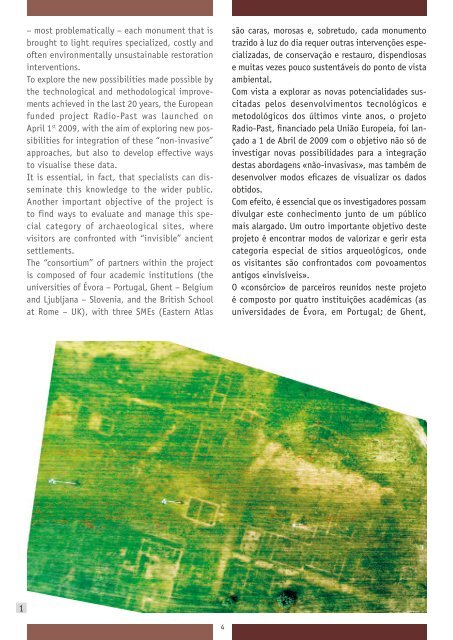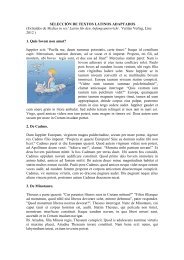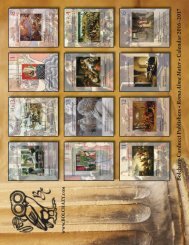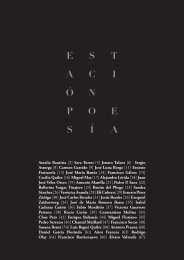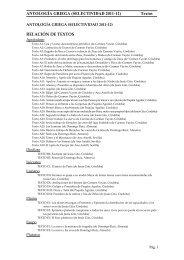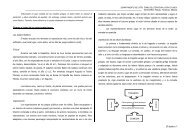Radiography of the past.Exploring “the invisible” inarchaeological sitesMost people think that archaeology is equal to“excavations” and that everything in archaeologyis about “finding”. Nothing could be further fromthe truth: archaeology is all about understandingand in some ways the closest parallel for our jobis with police investigative procedures.In addition to, and sometimes instead of, excavationmany other instruments and approachesare available to researchers for the reconstructionof ancient landscapes and townscapes.Aerial photography, for instance, has been usedby archaeologists since the origin of photographyitself, to “spot” from the air traces of buriedarchaeological features 1 . Equally, survey andsurface artefact collection are applied mainlyto detect the presence of human settlement,mostly in the countryside and in green-fieldareas. Relatively more recently (the first experimentswere performed in the 1940s) differentgeophysical survey techniques have been appliedto detect subsoil archaeological features. A lotof information can also be found in historicaldocuments and archives, in ancient sources andhistorical cartography.This wide range of research methodologies cantoday be defined as “archaeological diagnostics”:as in medicine, we can make a diagnosisassessing the state of the art (medical history),analysing the phenomena and evidence visiblefrom outside (symptomatology), applyinginstrumental diagnostics and finally resolvingto excavation (surgery) only when and wherereally needed, with the least “invasive” approachpossible.In this way, we can collect a lot of informationabout what is still buried under the ground, andin the best cases, once all these data are piecedtogether, we have something comparable to a“radiography” of the subsoil features 2 .The integration of all these techniques hasbrought archaeology in the third millenniumtoward a restraint from excavations, as excavationsare not only costly and time-consuming butRadiografia do passado.A exploração do «invisível»em sítios arqueológicosA maioria das pessoas pensa que arqueologia é sinónimode «escavações» e associa-a ao ato de «descobrir».Nada poderia estar mais longe da verdade: aarqueologia implica compreender e, neste sentido, épossível estabelecer uma comparação muito próximaentre o trabalho dos arqueólogos e os procedimentosda investigação policial.Para além de (e por vezes em vez de) escavações,os investigadores dispõem de muitos outros instrumentose abordagens que lhes permitem reconstituirantigas paisagens rurais e urbanas. A fotografiaaérea, por exemplo, é utilizada pelos arqueólogosdesde a origem da própria fotografia para «detetar»a partir do ar a presença de vestígios arqueológicossoterrados 1 . Da mesma forma, a prospeção e arecolha de artefactos à superfície do terreno aplicam--se para detetar a presença de antigas instalaçõeshumanas, sobretudo em zonas rurais. Mais recentemente(referimo-nos aqui a experiências realizadasa partir da década de 1940), diferentes técnicas deprospeção geofísica têm sido utilizadas para detetarvestígios arqueológicos no subsolo. É ainda possívelencontrar muita informação em documentos earquivos históricos, fontes documentais antigas ena cartografia histórica.Este vasto leque de instrumentos de investigaçãoenquadra-se atualmente no âmbito do chamado «diagnósticoarqueológico»: à semelhança do que sucedena medicina, é possível proceder a um diagnósticoonde se avalia o «estado da arte» (historial clínico),se analisam vestígios visíveis a partir do exterior(sintomatologia), se aplica o diagnóstico instrumentale, finalmente, se opta pela escavação (cirurgia), apenasquando e onde esta for estritamente necessária,recorrendo a uma abordagem o menos «invasiva» possível.Deste modo, podemos recolher muita informaçãosobre o que ainda se encontra soterrado e, uma vezreunidos todos estes dados, proceder, nos casos maisbem-sucedidos, a uma «radiografia» das realidadesocultas no subsolo 2 .A integração de todas estas técnicas conduziu aarqueologia, neste terceiro milénio, a uma contençãonas campanhas de escavação. As escavações3
– most problematically – each monument that isbrought to light requires specialized, costly andoften environmentally unsustainable restorationinterventions.To explore the new possibilities made possible bythe technological and methodological improvementsachieved in the last 20 years, the Europeanfunded project Radio-Past was launched onApril 1 st 2009, with the aim of exploring new possibilitiesfor integration of these “non-invasive”approaches, but also to develop effective waysto visualise these data.It is essential, in fact, that specialists can disseminatethis knowledge to the wider public.Another important objective of the project isto find ways to evaluate and manage this specialcategory of archaeological sites, wherevisitors are confronted with “invisible” ancientsettlements.The “consortium” of partners within the projectis composed of four academic institutions (theuniversities of Évora – Portugal, Ghent – Belgiumand Ljubljana – Slovenia, and the British Schoolat Rome – UK), with three SMEs (Eastern Atlassão caras, morosas e, sobretudo, cada monumentotrazido à luz do dia requer outras intervenções especializadas,de conservação e restauro, dispendiosase muitas vezes pouco sustentáveis do ponto de vistaambiental.Com vista a explorar as novas potencialidades suscitadaspelos desenvolvimentos tecnológicos emetodológicos dos últimos vinte anos, o projetoRadio‐Past, financiado pela União Europeia, foi lançadoa 1 de Abril de 2009 com o objetivo não só deinvestigar novas possibilidades para a integraçãodestas abordagens «não-invasivas», mas também dedesenvolver modos eficazes de visualizar os dadosobtidos.Com efeito, é essencial que os investigadores possamdivulgar este conhecimento junto de um públicomais alargado. Um outro importante objetivo desteprojeto é encontrar modos de valorizar e gerir estacategoria especial de sítios arqueológicos, ondeos visitantes são confrontados com povoamentosantigos «invisíveis».O «consórcio» de parceiros reunidos neste projetoé composto por quatro instituições académicas (asuniversidades de Évora, em Portugal; de Ghent,14


